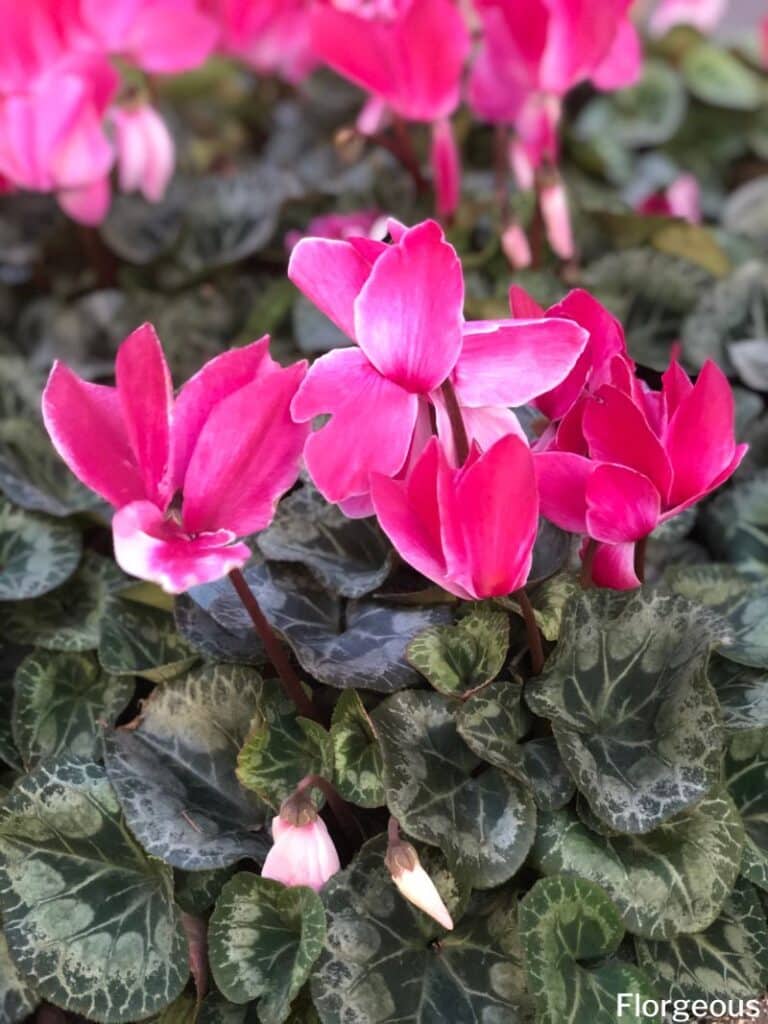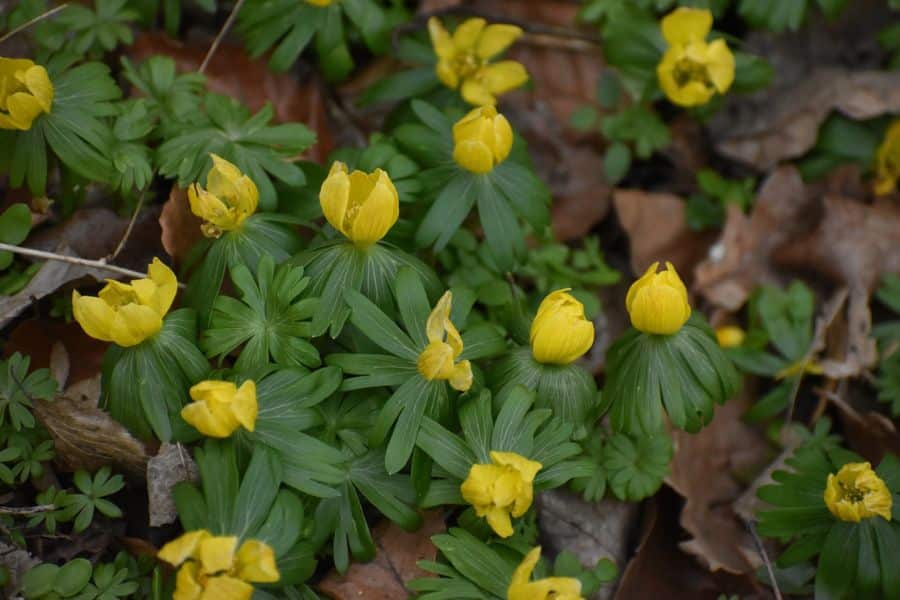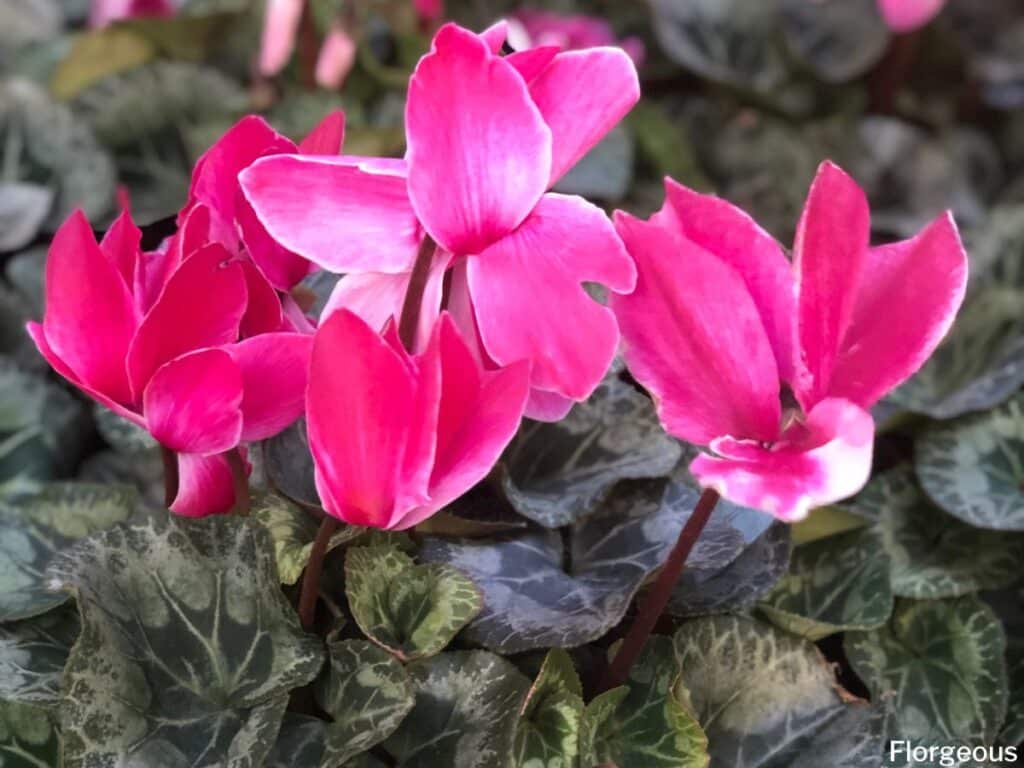Cyclamen (Cyclamen persicum) is beloved by florists because this flowering plant is one of the few that flowers during the winter and early spring months. It produces lots of vivid colored flowers that can brighten up your home or garden during those months that tend to be so dull and bleak.
There are 23 different cyclamen species and they all produce bright colored flowers in colors like white, all shades of pink, lavender, and red. Some of these varieties produce single flowers while other species create double blooms.
You can pair different cyclamen varieties in your garden bed if you want bursts of color. Many gardeners do, however, prefer to pair cyclamen with other plant species that can prolong the interest in your garden beds during the warmer seasons or that can add more texture and charm to these flowers.
There are quite a few different plant varieties that will grow well alongside cyclamen but in this guide, we are only going to discuss the best and most popular companions for these flowers.
What to Plant with Cyclamens

When you are growing cyclamen and want to pair it with other plant species in a container or garden bed then you should always focus on garden plants that have similar growing requirements.
Cyclamen grow very well around the base of deciduous trees and shrubs in shaded areas. These trees or shrubs will offer plenty of cool shade during warmer summers but allow lots of sunlight to filter through during the cooler months so your flowers can bloom vigorously.
You can however position these flowers in areas where they will receive lots of dappled shade or indirect light.
Many gardeners prefer to keep indoor cyclamen in containers so they can move these potted plants into the shade during the warmer seasons or towards the light during winter.
The flowers need to be planted in well-draining soil that is kept moist. They can grow well in most soil types including clay soils as long as it drains properly.
Here is a quick look at some other plant species that will grow well in a shade garden next to hardy cyclamen.
Persian Violet
Persian violet flowers (Exacum affine) are terrific ornamental flowers to grow next to cyclamen tubers because they start to bloom from early spring to late summer. The blueish-purple or white flowers of this short-lived biennial flower will add lots of color to your garden bed during this time.
Persian violet plants will thrive outdoors but are often grown indoors along with cyclamen species because they develop very well in indirect sunlight areas.
You can plant persian violets in any shaded area in the garden in any soil type and even in a rock garden. The plants prefer high humidity levels and should be watered regularly.
These bushy plants will only grow up to 12 inches tall and because it has a similar height to cyclamen, you can easily plant these flowers along the cyclamen plant tubers.
The dark green leaves of cyclamen will look striking next to the lighter leaves of Persian violets and the purple tones will complement the vivid flowers of most cyclamen species very well.
Azaleas
Azaleas (similar to rhododendrons), are excellent plants to use if you want to create a vivid backdrop in your garden. These bushy shrubs start producing masses of flowers from late winter to late spring or from autumn to spring and will look rather striking behind your cyclamen flowers.
Azaleas grow well in shade garden areas and can handle a little bit of direct sun but they won’t grow well in direct sun or deep shade. These flowering shrubs also prefer humus-rich neutral soil that is kept moist. It is especially important to keep the soil moist during its flowering season or it could drop its blooms.
There are quite a few different varieties of azalea flowers in colors like white, purple, pink, red, orange, or yellow. The best way to pair azaleas and cyclamens is by adding a contrasting cyclamen species in front of the shrubs.
Pairing two similar colors like light pink azaleas with cyclamen hederifolium can be a waste of time since the cyclamens will hardly be visible behind a bush of flowers with virtually the same color.
With contrasting colors, both of these hardy species can stand out and add lots of vibrant color during the colder months.
Hellebores

Hellebores (Helleborus) are also winter-blooming flowers which makes them good companion plants for cyclamen plants.
This woodland plant species will add lots of color to your garden because they produce blooms in colors like apricot, green, metallic blue, yellow, dusty pink, maroon, or white and there are even some with interesting flower leaf patterns.
Hellebores grow very well in dappled shade and they need to be established in moist but well-draining soil. These flowers don’t mind tree roots and can easily be grown around the trees in your garden.
Hellebores are slow growers that only grow to a height of 12 inches so you can easily grow them amongst your florist’s cyclamen. These perennials can take up to 3 years to fully mature which means you will need to take good care of the cyclamen plant tubers while waiting for these plants to fully mature.
Since cyclamen flowers don’t like freezing temperatures, many gardeners prefer to remove them from the soil and store them for these colder months.
Snowdrops

Snowdrops (Galanthus) are gorgeous plants to include in your spring flower bed if you want to add lots of delicate texture to these shade gardens. The crisp white snowdrop bulbs will look rather striking next to the heart-shaped leaves of cyclamen foliage.
Snowdrops are the perfect companion plant species for cyclamen flowers because they are also some of the earliest flowers to bloom in spring.
These delicate white flowers will grow well in moist soil that drains properly. They prefer partial shade and should be grown in shaded areas throughout the year because they require summer shade even though they are summer dormant.
Snowdrops should be planted in front of your cyclamen species because they tend to be a little bit shorter with a maximum height of just 10 inches tall. Ideally, you should pair these flowers with a lighter-colored plant like cyclamen repandum or cyclamen coum because deep pink varieties might be a bit too overwhelming.
Winter Aconite

Winter aconite (Eranthis) are members of the buttercup family that also bloom in spring. When they bloom, they produce lots of vivid yellow flowers before entering summer dormancy.
These vivid yellow flowers can look rather striking next to cyclamen species that are warm tones like red cyclamen or vivid colors like dark pink cyclamen.
Winter aconite should be grown in partial shade in moist soil that drains well. It is best to plant these tubers during early fall so they can be ready to flower along with the other young plants in your garden.
These low-profile plants should be grown in front of your hardy cyclamen species because they are much shorter with a maximum height of just 6 inches tall.
What NOT to Plant with Cyclamens
Cyclamens can grow well alongside a great many plant species but not all plants can grow in the same area. Gardners also tend to avoid certain pairings because it just doesn’t work.
Here is a quick look at plant combinations to avoid.
Summer Blooming Plants
Cyclamens are mostly paired with plants that have a similar bloom season because this will enhance the look of these flowers. You can grow them next to perennials that bloom during late spring or summer if you want to create multi-season interest in your garden but, because cyclamen species are dormant during summer, they won’t offer additional interest or charm.
Sun Loving Plants
Cyclamens won’t grow well in direct sunlight. Sun-loving plant varieties also don’t grow too well in shady areas. If you grow plant varieties like sage, coneflowers, or black-eyed susans where you are growing cyclamen, their growth will be stunted.
FAQs
Where is the best place to plant cyclamen?
Cyclamen is best planted in locations with dappled shade or partial sunlight, such as beneath deciduous trees or in areas where they receive filtered sunlight. Well-draining soil with good organic content is crucial to ensure the health and longevity of cyclamen plants.
Is cyclamen an acid loving plant?
Yes, cyclamen is generally considered an acid-loving plant, and it thrives in soil with a slightly acidic to neutral pH. Providing well-draining, humus-rich soil with an acidic component, such as peat moss, can contribute to the optimal growth of cyclamen.
What do cyclamen attract?
Cyclamen primarily attract pollinators such as moths, butterflies, and small bees. The flowers have a long, twisted corolla tube that only these insects can reach to get nectar.
Final Thoughts
If you want to get the most out of your florist’s cyclamen flowers then it is best to pair them with other spring flowers like snowdrops, winter aconite, hellebores, azaleas, or Persian violet flowers. Most of these species will bloom at the same time and will quickly become dormant so you can easily extract the tubers and preserve them for next year.
We hope that this guide made it easier to find great companions for your cyclamen species. If you are adding other plants to your garden then we recommend you have a look at some of our other guides where we discuss other great plant combinations that can help you grow a much more beautiful garden.
Don’t forget to check our article on cyclamen flower meaning to learn more about this plant.







